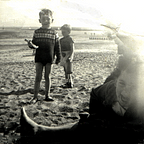Christmas by John Betjeman
The holly in the windy hedge…
Christmas
The holly in the windy hedge
And round the Manor House the yew
Will soon be stripped to deck the ledge,
The altar, font and arch and pew,
So that the villagers can say
‘The church looks nice’ on Christmas Day.
Provincial Public Houses blaze,
Corporation tramcars clang,
On lighted tenements I gaze,
Where paper decorations hang,
And bunting in the red Town Hall
Says ‘Merry Christmas to you all’.
And London shops on Christmas Eve
Are strung with silver bells and flowers
As hurrying clerks the City leave
To pigeon-haunted classic towers,
And marbled clouds go scudding by
The many-steepled London sky.
And girls in slacks remember Dad,
And oafish louts remember Mum,
And sleepless children’s hearts are glad.
And Christmas-morning bells say ‘Come!’
Even to shining ones who dwell
Safe in the Dorchester Hotel.
And is it true? And is it true,
This most tremendous tale of all,
Seen in a stained-glass window’s hue,
A Baby in an ox’s stall ?
The Maker of the stars and sea
Become a Child on earth for me ?
And is it true ? For if it is,
No loving fingers tying strings
Around those tissued fripperies,
The sweet and silly Christmas things,
Bath salts and inexpensive scent
And hideous tie so kindly meant,
No love that in a family dwells,
No carolling in frosty air,
Nor all the steeple-shaking bells
Can with this single Truth compare -
That God was man in Palestine
And lives today in Bread and Wine.
Like Hardy, John Betjeman wrestled with the religious faith he was born into and in his teens was briefly an atheist. He returned to the Anglican church and for the rest of his life was an active member. His public celebration of its architecture and traditions has perhaps obscured an ongoing struggle with doubt. As Terry Philpott puts it:
Outwardly, Betjeman lived a traditional Anglican existence — a regular churchgoer, bell ringer, church warden and parochial church council member. Yet behind these appearances, there was… a profound and troubled spiritual existence.
The opening stanzas mask this trouble. They feel like a jocular response to Dylan Thomas — the English suburban child’s view of Christmas. But they lead to the existential question:
And is it true? And is it true,
This most tremendous tale of all,
Seen in a stained-glass window’s hue,
A Baby in an ox’s stall?
In The Oxen, Hardy suspends disbelief (‘Hoping it might be so’). Betjeman affirms what Søren Kierkegaard calls a ‘leap of faith’:
No love that in a family dwells,
No carolling in frosty air,
Nor all the steeple-shaking bells
Can with this single Truth compare -
That God was man in Palestine
And lives today in Bread and Wine.
The Oxen by Thomas Hardy
A Child’s Christmas in Wales by Dylan Thomas
